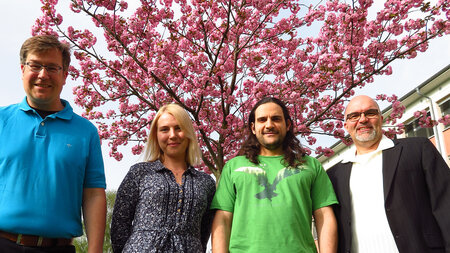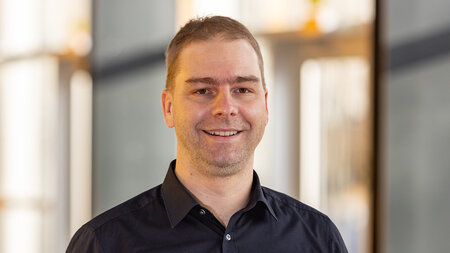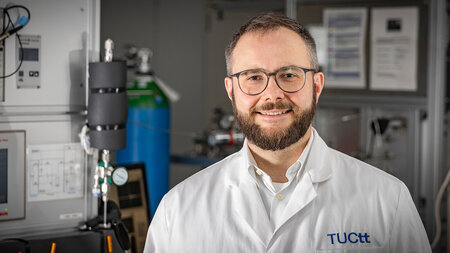MAIN Research Center Opens its Doors
The Chemnitz University Research Center for Materials, Architectures and Integration of Nanomembranes (MAIN) was officially opened on August 13, 2018
-
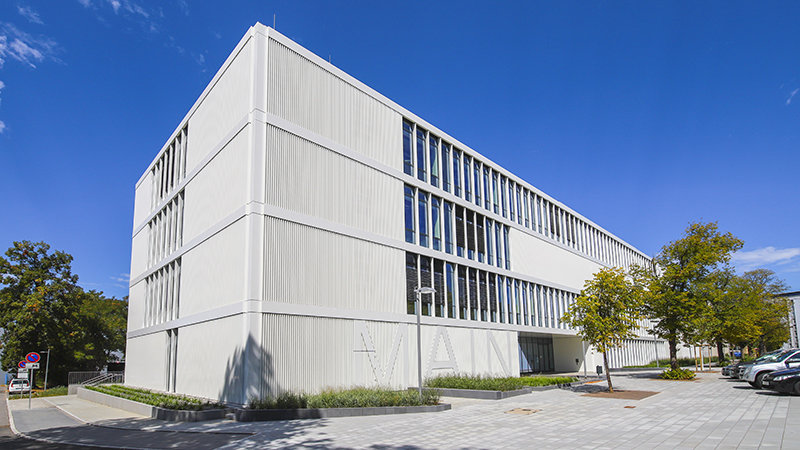
The four-story MAIN building creates a new visual profile as visitors enter the Chemnitz University Campus located on Reichenhainer Straße. Along with several cleanrooms, the building houses numerous laboratories equipped with cutting-edge tools and devices. -
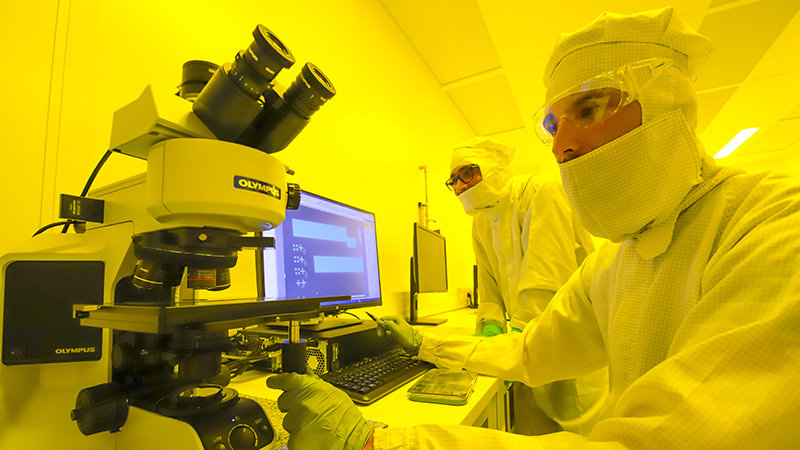
In the lithography area of a cleanroom located within the MAIN building, Eric Pankenin (front) and Rachappa Ravishankar of the Professorship of Material Systems for Nanoelectronics at Chemnitz University use an optical microscope for process control. Photo: Jacob Müller -
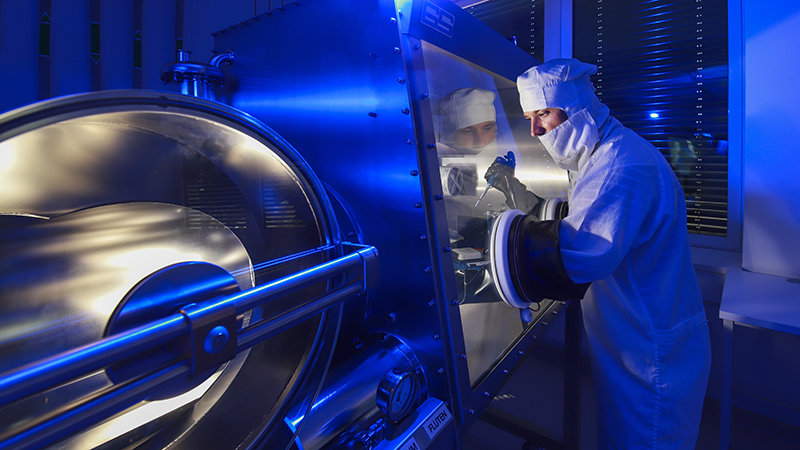
Eric Pankenin, member of the scientific staff of the Professorship of Material Systems for Nanoelectronics, inspects the operation of a hermetically-sealed and gastight glovebox inside a cleanroom. Using this glovebox, researchers can work with sensitive or dangerous materials in a sealed atmosphere using inert gas. Photo: Jacob Müller -
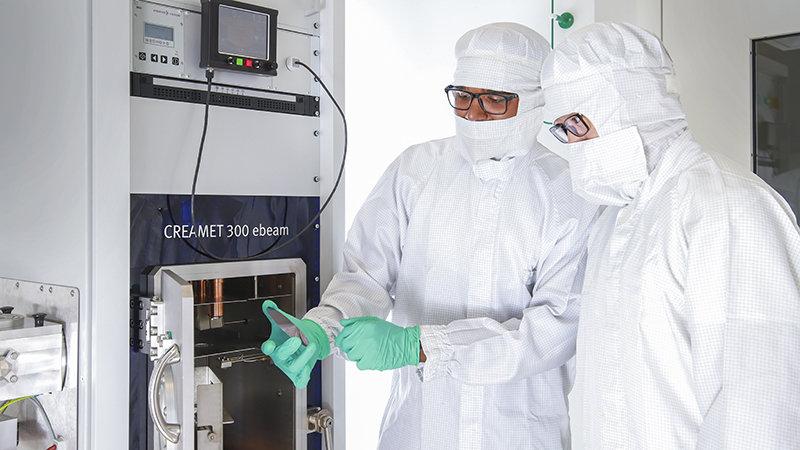
View of the cleanroom section for coating technology in the MAIN building: Karthikeyan Manga Loganathan (left) und Yu Hong of the Professorship of Material Systems for Nanoelectronics inspect a wafer that has been coated with a very pure and thin coating using a new electron beam evaporator, which operates on a nanometer scale. These layers are the subject of various new research and development areas within the field of nanotechnology. Photo: Jacob Müller -
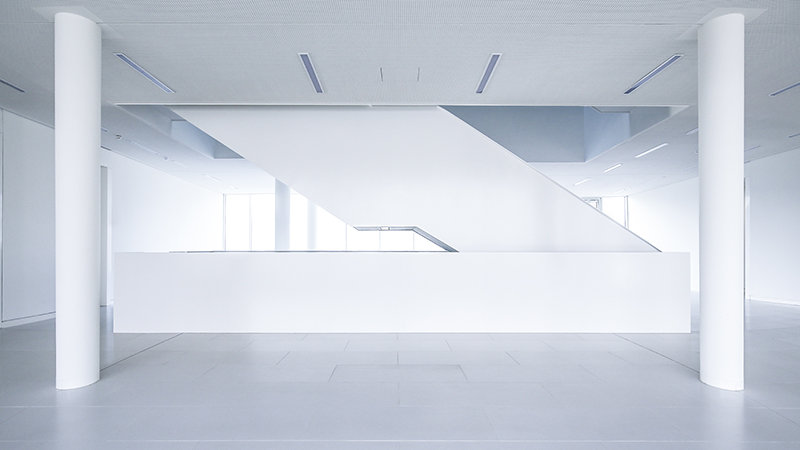
Beyond the main corridor, the foyer is open on the entire ground floor to the south-facing façade. Photo: Jacob Müller -
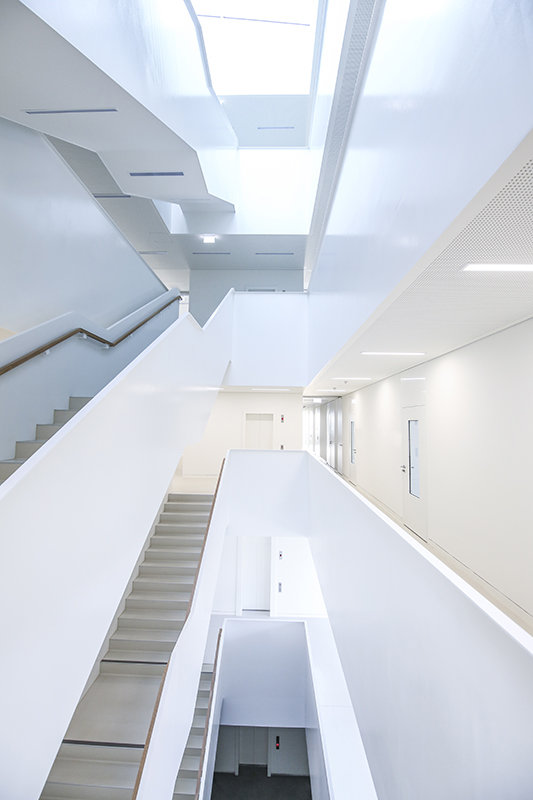
Walking through the foyer, visitors enter a large open hall featuring a sleek metal staircase. The stairs extend vertically through the entire building. At the top, a glass ceiling allows natural light to illuminate the space, including lower floors. Photo: Jacob Müller -
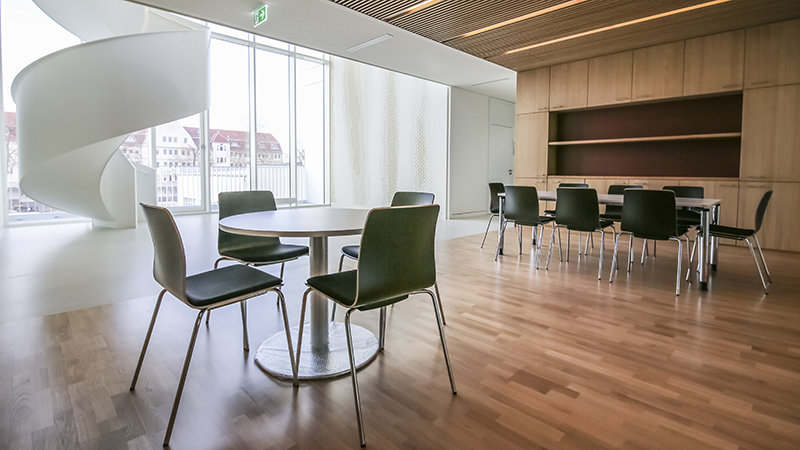
The MAIN Research Center also includes two “knowledge gardens”, which unite the individual research areas with one another across the levels of the building and improve interdisciplinary communication. -
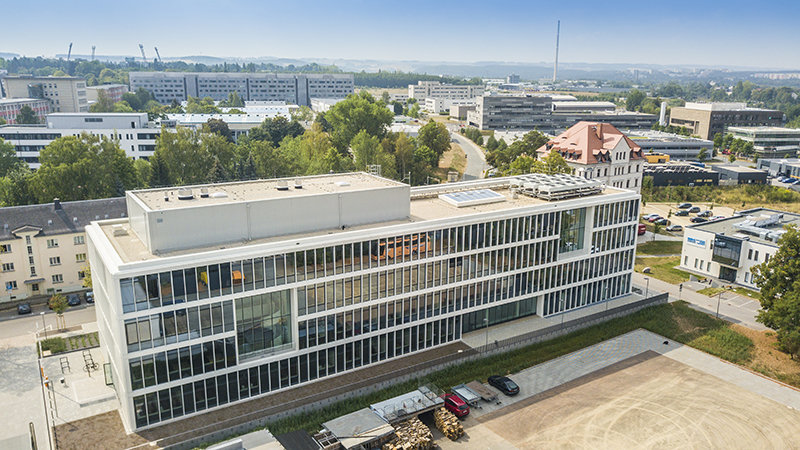
A bird’s eye view: The MAIN building benefits from its close proximity to the Start-Up-Center as well as small and medium-sized enterprises on the neighboring Smart Systems Campus. Photo: Jacob Müller
The newly-constructed Center for Materials, Architectures and Integration of Nanomembranes (MAIN), located on Rosenbergstraße in Chemnitz, was officially opened on August 13, 2018. The Saxon State Ministry of Finance presented the building to Chemnitz University of Technology during the opening ceremony. Construction of the laboratory building was government-funded with approximately 34.3 million euros and the MAIN Research Center will provide around 100 scientists with state-of-the-art facilities for research.
Rigid High Speed Electronics Made Flexible
At MAIN, Chemnitz University will strengthen and expand its competencies in the domain of nanomembrane-based materials, one of the most modern fields in materials engineering. The term “nanomembranes” refers to extremely thin functional structures, which exhibit a high degree of mechanical flexibility. They form the basis for innovative types of construction elements that are flexible, stretchable and shapeable and are therefore extremely adaptable. These elements can be manufactured using established and novel processes and techniques, which will be developed in part in MAIN. In the long term, this could lead to totally new scenarios in mobile communication, medical engineering or energy technology.
Unprecedented Possibilities for Everyday Life
“Around the world, the development of sensors that are increasingly more compact and more intelligent is opening up unprecedented possibilities for everyday life and is stimulating visionary ideas that go far beyond what is possible today. At MAIN, the central components of such systems will be researched, like ultra-compact energy storage units for tiny, autonomously-operating sensor nodes or flexible sensor systems to implement the concept of artificial skin,” predicts MAIN initiator Prof. Dr. Oliver G. Schmidt. He is the Head of the Professorship of Material Systems for Nanoelectronics at Chemnitz University and Director of the Institute for Integrative Nanosciences at the Leibniz Institute for Solid State and Materials Research Dresden. “The interdisciplinary scientific and technological potential of inorganic and hybrid flexible nanomembranes is clearly recognized, but still remains largely unexplored,” says Schmidt. For this reason, he established this field more than a decade ago for the first time in Germany and across Europe. Because of this, the Chemnitz-Dresden region is an international leader in this domain today. Schmidt is a pioneer in the field of rolled-up nanotubes and his work encompasses elements of chemistry, physics, materials engineering, electrical engineering and microsystems technology. He is working to integrate self-organized, three-dimensional nanostructures on a chip. For his outstanding work in researching, manufacturing and the innovative application of functional nanostructures, he received the Gottfried Wilhelm Leibniz Award in 2018.
Strengthening the University’s Core Competency in Materials and Intelligent Systems
“In particular, the research that will be conducted in the Center for Materials, Architectures and Integration of Nanomembranes will serve to further strengthen Chemnitz University’s core competency in Materials and Intelligent Systems and will reinforce the university’s national and international visibility in this domain,” says Prof. Dr. Gerd Strohmeier, President of Chemnitz University. MAIN’s central objective is to contribute to the advancement of basic and application-oriented research in the field of nanomembrane-based materials.
Interdisciplinary Cooperation Under One Roof
“Through MAIN, we will integrate research on the fundamental principles and new phenomena of the structure-property relationship, the development of innovative architectures, the continuing development and use of system integration processes and harnessing application possibilities. This integration, the first of its kind in Europe, will be made possible by the interdisciplinary team that will be established in the MAIN research facilities,” says Prof. Dr. Thomas Otto, Head of the Professorship of Microtechnology and Leader of the Task Force for the Implementation of MAIN. “Now, under one roof, existing excellent activities carried out by the Chemnitz University Faculties of Natural Sciences as well as Electrical Engineering and Information Technology and their research partners can be brought together into one very promising thematic field,” continues Otto. Cooperation with Institutes belonging to research organizations outside of the university, like Fraunhofer, Leibniz and Helmholtz, will be enhanced. In order to ensure long-term, high-quality interdisciplinary research, projects will be initiated in programs of the DFG (German Research Foundation), State and Federal Ministries and the European Union. The close proximity of MAIN to the Start-Up-Center as well as small and medium-sized enterprises located on the neighboring Smart Systems Campus creates ideal conditions for efficient technology transfer.
Keyword: Newly-Constructed MAIN Research Building
The 78-meter-long MAIN building creates a new, distinct visual profile at the entrance to the Chemnitz University Reichenhainer Straße Campus. The construction was carried out according to the winning design created by the Heinle, Wischer und Partner architecture firm located in Dresden. The building, with approximately 3,800 square meters of usable space, was constructed using a reinforced concrete structure with load-bearing walls and ceilings in order to enable vibration-free measurements. Further protection from vibration for the sensitive laboratory equipment comes from the approximately 1.6-meter-thick foundation slab made of reinforced concrete. The cleanrooms are a functional highlight of the center, which will enable researchers to manufacture components in a dust-free environment. Two so-called “knowledge gardens” are also located within the building, in order to create a space for workers to meet and exchange information. They also contribute to the idea of connection among all research domains across the building’s floors. These spaces were designed by Dresden-based artist Patricia Westerholz, who won the “Kunst am Bau” competition with her submission, “layers and structures.”
More Information about the “Center for Materials, Architectures and Integration of Nanomembranes” (MAIN) is available from Prof. Dr. Uwe Götze, Tel.: +49 371 531-10030, E-mail: ptw@tu-chemnitz.de, Prof. Dr. Thomas Otto, Tel.: +49 531-36650, E-mail: thomas.otto@zfm.tu-chemnitz.de, Prof. Dr. Oliver G. Schmidt, Head of the Professorship of Material Systems for Nanoelectronics at Chemnitz University, Tel.: +49 371 531-33432, E-mail: oschmidt@etit.tu-chemnitz.de.
Mario Steinebach
13.08.2018

